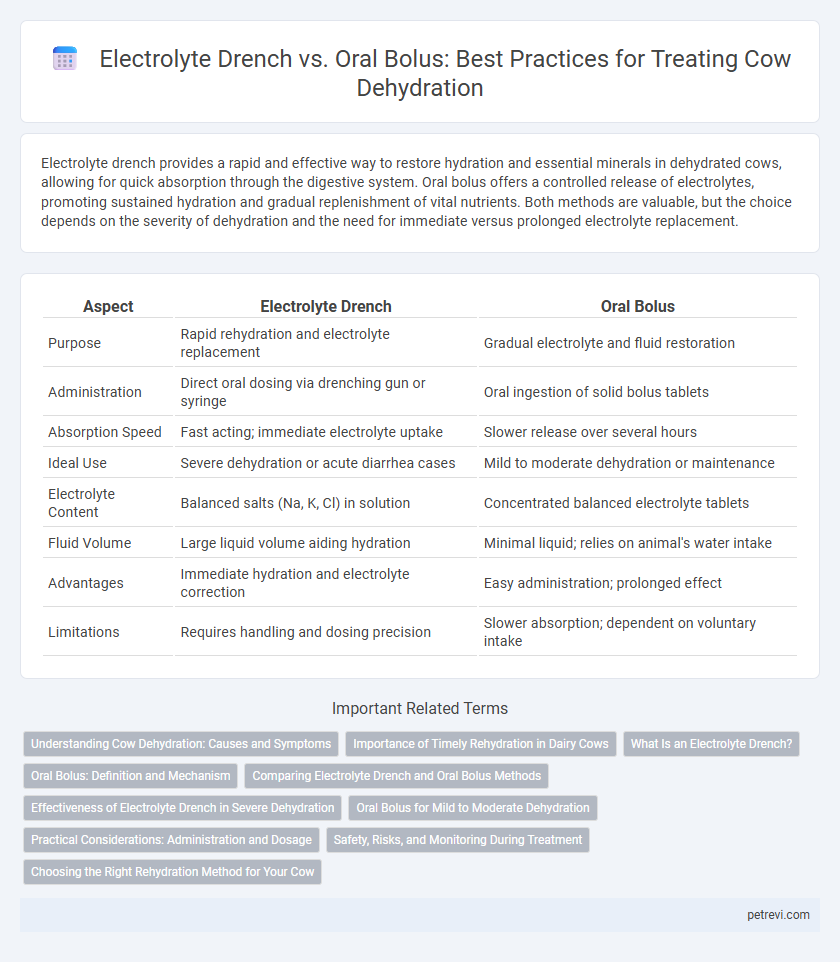Electrolyte drench provides a rapid and effective way to restore hydration and essential minerals in dehydrated cows, allowing for quick absorption through the digestive system. Oral bolus offers a controlled release of electrolytes, promoting sustained hydration and gradual replenishment of vital nutrients. Both methods are valuable, but the choice depends on the severity of dehydration and the need for immediate versus prolonged electrolyte replacement.
Table of Comparison
| Aspect | Electrolyte Drench | Oral Bolus |
|---|---|---|
| Purpose | Rapid rehydration and electrolyte replacement | Gradual electrolyte and fluid restoration |
| Administration | Direct oral dosing via drenching gun or syringe | Oral ingestion of solid bolus tablets |
| Absorption Speed | Fast acting; immediate electrolyte uptake | Slower release over several hours |
| Ideal Use | Severe dehydration or acute diarrhea cases | Mild to moderate dehydration or maintenance |
| Electrolyte Content | Balanced salts (Na, K, Cl) in solution | Concentrated balanced electrolyte tablets |
| Fluid Volume | Large liquid volume aiding hydration | Minimal liquid; relies on animal's water intake |
| Advantages | Immediate hydration and electrolyte correction | Easy administration; prolonged effect |
| Limitations | Requires handling and dosing precision | Slower absorption; dependent on voluntary intake |
Understanding Cow Dehydration: Causes and Symptoms
Cow dehydration arises primarily from excessive fluid loss due to diarrhea, heat stress, or inadequate water intake, leading to electrolyte imbalances. Symptoms include sunken eyes, dry mucous membranes, reduced skin elasticity, and lethargy, which signal the need for immediate rehydration therapy. Differentiating between electrolyte drenches and oral boluses involves recognizing the severity of dehydration and electrolyte depletion to choose the most effective treatment method.
Importance of Timely Rehydration in Dairy Cows
Timely rehydration in dairy cows suffering from dehydration is critical to prevent severe metabolic disturbances and maintain milk production. Electrolyte drench offers rapid absorption of essential minerals like sodium, potassium, and chloride to restore fluid balance quickly, while oral bolus provides a sustained release of electrolytes for prolonged rehydration. Choosing the appropriate method depends on the severity of dehydration and the cow's overall health, ensuring optimal recovery and minimizing production losses.
What Is an Electrolyte Drench?
An electrolyte drench is a liquid solution containing essential minerals such as sodium, potassium, chloride, and bicarbonate, designed to rapidly restore hydration and electrolyte balance in dehydrated cows. Typically administered using a drenching gun, this treatment is vital for cows suffering from diarrhea, heat stress, or other conditions leading to fluid loss. Electrolyte drenches provide immediate absorption of minerals and fluids, making them a preferred choice for swift rehydration compared to oral boluses that release electrolytes more slowly.
Oral Bolus: Definition and Mechanism
Oral bolus for cow dehydration treatment refers to a concentrated dose of electrolytes and fluids administered orally to rapidly restore hydration and electrolyte balance. This method leverages the rumen's absorption capacity, allowing electrolytes to be efficiently absorbed into the bloodstream, promoting swift rehydration and preventing metabolic imbalances. The oral bolus mechanism supports digestive health while delivering essential minerals like sodium, potassium, and chloride to correct dehydration.
Comparing Electrolyte Drench and Oral Bolus Methods
Electrolyte drench and oral bolus methods are both effective for treating dehydration in cows, but they differ in application and absorption rates. Electrolyte drenches are liquid solutions that provide rapid rehydration and electrolyte replenishment, ideal for immediate recovery in severely dehydrated cattle. Oral boluses release electrolytes more slowly, offering a controlled and sustained hydration effect suitable for mild to moderate dehydration cases.
Effectiveness of Electrolyte Drench in Severe Dehydration
Electrolyte drenches provide rapid rehydration by delivering essential minerals directly to cattle, making them highly effective in treating severe dehydration. The high concentration of sodium, potassium, and chloride in electrolyte drenches facilitates quick restoration of fluid balance and muscle function. Compared to oral boluses, drenches offer faster absorption, which is crucial for cows experiencing acute fluid loss.
Oral Bolus for Mild to Moderate Dehydration
Oral bolus treatment for mild to moderate dehydration in cows provides a balanced mix of electrolytes and glucose that supports rapid rehydration and energy replenishment. This method ensures precise dosing with minimal stress, improving recovery times compared to general electrolyte drenches. Oral boluses are especially effective in maintaining rumen function and preventing further fluid loss during dehydration management.
Practical Considerations: Administration and Dosage
Electrolyte drench offers rapid rehydration through a liquid solution easily administered via a dosing gun, allowing precise control of dosage based on the severity of dehydration in cows. Oral boluses provide a slow-release mechanism that is less labor-intensive but may require multiple doses over time to achieve optimal electrolyte balance. Practical administration favors electrolyte drenches for acute cases due to immediate absorption, while oral boluses suit maintenance or mild dehydration with minimal stress to the animal.
Safety, Risks, and Monitoring During Treatment
Electrolyte drenches provide a rapid, controlled rehydration for cows with mild to moderate dehydration, minimizing the risk of aspiration when administered correctly. Oral boluses offer a convenient method to restore electrolyte balance but require careful monitoring for dosage accuracy and signs of choking or esophageal injury. Continuous monitoring during treatment is essential to detect adverse reactions, ensuring timely intervention and maintaining cow safety.
Choosing the Right Rehydration Method for Your Cow
Choosing the right rehydration method for cow dehydration involves evaluating the severity of fluid loss and electrolyte imbalance. Electrolyte drench offers rapid absorption through the oral mucosa, making it ideal for mild to moderate dehydration cases, while oral bolus provides a sustained release of fluids and minerals, suitable for prolonged recovery and severe dehydration. Understanding factors like dehydration degree, cow's energy status, and electrolyte needs ensures effective rehydration and quicker return to health.
Electrolyte drench vs Oral bolus for Cow dehydration treatment Infographic

 petrevi.com
petrevi.com